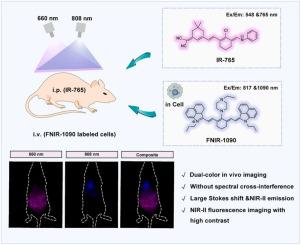Sensors and Actuators B: Chemical ( IF 8.0 ) Pub Date : 2023-09-09 , DOI: 10.1016/j.snb.2023.134595 Huixian Jia , Yujie Liu , Wei Tang , Chenghui Liu , Xinrui Duan

|
Multiplexed fluorescence imaging is mainly applied to cellular imaging. However, the application of an analogous technique to mammals remains challenging due to the presence of substantial scattering and autofluorescence in biological tissues in the visible (350–700 nm) and near-infrared I region (NIR-I, 700–900 nm). Herein, we report multiplexing excitation and single-channel detection in the near-infrared II region (NIR-II) with two fluorescent probes for dual-color imaging in vivo. The first one, FNIR-1090 was constructed on Pr-1099 derivative by attaching with 1-Ethylpiperazine through the SRN1 displacement reaction. The second one, IR-765 was synthesized by a one-step reaction between the Vilsmeier–Haack reagent with 2-(3,5,5-trimethylcyclohex-2-enylidene) malononitrile (TEMO). It is noteworthy that the absorption spectrum of FNIR-1090 is almost completely separated from that of IR-765, which facilitates dual-color in vivo imaging. The two dyes can be used for high-contrast dual-channel vivo imaging of different tissues. All these prominent performances show the great promise of FNIR-1090 and IR-765 in non-invasive, real-time, and dual-color NIR-II imaging (>900 nm) in vivo.
中文翻译:

用于无创、实时、双色体内 NIR-II 成像的近红外荧光探针
多重荧光成像主要应用于细胞成像。然而,由于生物组织在可见光(350-700 nm)和近红外 I 区域(NIR-I,700-900 nm)中存在大量散射和自发荧光,因此将类似技术应用于哺乳动物仍然具有挑战性。在此,我们报告了使用两种荧光探针在近红外 II 区域 (NIR-II) 进行多重激发和单通道检测用于体内双色成像。第一个 FNIR-1090 是在 Pr-1099 衍生物上通过 SRN1 置换反应与 1-乙基哌嗪连接而构建的。第二种是 IR-765,是通过 Vilsmeier-Haack 试剂与 2-(3,5,5-三甲基环己-2-烯基)丙二腈 (TEMO) 之间的一步反应合成的。值得注意的是,FNIR-1090的吸收光谱与IR-765的吸收光谱几乎完全分离,这有利于双色体内成像。这两种染料可用于不同组织的高对比度双通道活体成像。所有这些突出的性能都表明了 FNIR-1090 和 IR-765 在体内非侵入、实时、双色 NIR-II 成像(>900 nm)方面的巨大前景。































 京公网安备 11010802027423号
京公网安备 11010802027423号